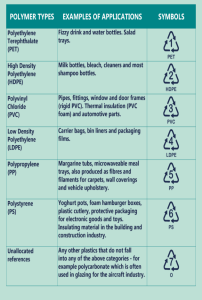Plastics and its Problems
Why in the news?
Plastic recycling could be a solution to the growing problems of plastics.
What are plastics?
- Plastics are a group of materials, either synthetic or naturally occurring, that may be shaped when soft and then hardened to retain the given shape.
- Plastics are polymers. A polymer is a substance made of many repeating units
- Plastics can be divided into two general categories–thermoplastics and thermosets.
- Thermoplastics are defined as polymers that can be melted and recast almost indefinitely.
- Thermosets are a polymer that irreversibly becomes rigid when heated.

What are the disadvantages of plastics?
- Plastic manufacturing also involves the addition of potentially hazardous compounds like stabilizers or colourants.
- Most plastics are non-biodegradable and they might take a long time to decompose
- Plastic materials clog waterways, oceans, seas, lakes etc.
- 1 in 3 species of marine mammals have been found entangled in marine litter.
- Eating food out of plastic containers may cause cancer.
- Many animals eat plastic materials and die
- A few additives such as phthalates which are added in plastics to prevent its structure may cause serious hormonal imbalance in males and females.
What is the recycling of plastics?
- Plastic recycling has been described as the process of recovering scrap or waste plastics and reprocessing the material into useful products
- The two methods of recycling plastics are:
- Traditional Recycling –The traditional recycling method involves melting plastics and processing them into new plastic products.
- Advanced Recycling – Advanced recycling is a process through which the effect of chemicals breaks down plastic material.
- This method consists of three other techniques. These techniques include pyrolysis, chemical recycling, and gasification.
What are the reasons for the low rate of plastic recycling?
- Segregation – Unsegregated plastic waste being ended up in landfills and water systems.
- Lack of segregation of plastic waste at a local community level.
- Segregation of plastic at the household level has remained largely unsuccessful.
- No market –For plastics recycling for 5 types of plastics except Polyethylene terephthalate, high-density Polyethylene (HDPE).
- Virgin plastics –Being cheaper than recycled plastics
- Multi-layered plastics – The plastics having multilayer are hard for recycling
- Lightweight flexible packaging – This industry is booming but it is non-recyclable
What are the efforts taken by India to mitigate plastics pollution?
- Since July 1, 2022, India has banned the manufacture, import, stocking, distribution, sale, and use of single-use plastic items with low utility and high littering potential.
- Plastic Waste Management Amendment Rules, 2021 – prohibits identified single-use plastic items by 2022
- The thickness of plastic carry bags increased from 50 to 75 microns in 2021 and to 120 microns with effect from 2022
- Plastic Waste Management Amendment Rules, 2022- The guidelines provide a framework to Strengthen the circular economy of plastic packaging waste.
- Promote the development of new alternatives to plastic packaging.
- Provide the steps for moving towards sustainable plastic packaging by businesses.
Way Forward
- To create a viable market for plastics other than.
- To use eco-friendly products like bamboo, jute, coconut etc.. to replace plastics.
- Use of circular model economy.
